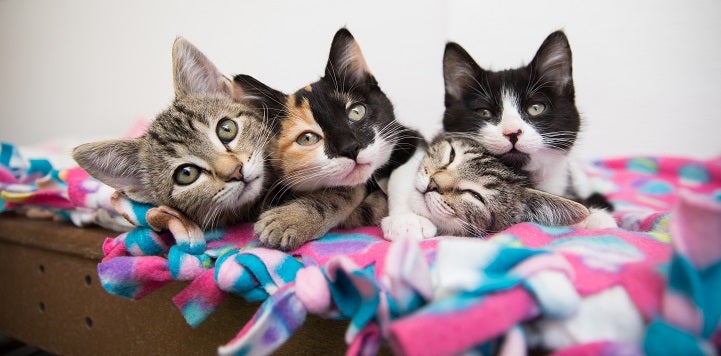
No-Kill Doesn't Mean No Challenges
New England States Forge Path to Next Phase of Animal Sheltering
As you saw in our recent data analysis, shelters are closing in on the goal of becoming a no-kill country by 2025. And nowhere is progress towards 90% faster than among the New England states of Maine, Vermont, Rhode Island, Connecticut and Massachusetts—and of course, New Hampshire, which reached no-kill in 2020. The rest of the region’s states are close behind*:
Such progress can be attributed to a variety of elements, including effective spay and neuter programs, hard-won legislative victories and progressive shelter leadership. Though the impact of COVID initially caused some concern that intakes would rise in conjunction with evictions and returns to the office, data has shown this is not yet the case. It seems that in New England, low shelter populations are here to stay.
But shelters in these states are not empty, and communities are not without need. Today, New England shelters face a different, more refined set of challenges—and they are doing so without a roadmap.
Serving New Populations
Historically, the battle for no-kill in shelters has been about managing intake volume. More pets were coming into shelters than leaving, leading to the practice of killing for space. But animals in need of new homes are increasingly finding them through direct rehoming that does not even involve the shelter system. That means shelter populations look different and include many that are the most difficult to place. While there are still many highly adoptable pets in these shelters, animals with behavioral challenges, senior pets, and those with medical needs make up a substantial percentage of the population entering shelters in New England today.
Shelters in this part of the country have been ahead of the curve on important animal welfare policies like accessible, low-cost spay/neuter programs for years. Today they are concentrating on programs geared toward these “figure-it-out(come)" populations, where out-of-the-box thinking and a case management approach is driving lifesaving. Providing tailor-made solutions to each pet ensures that each animal has what they need for the best chance at a live outcome—even when they have complicated medical and behavioral needs.
This might look like investing in community cat programs; building extensive behavior and enrichment programming for behaviorally challenged animals; recruiting expert long-term fosters who can provide alternative housing and better serve animals with complex needs; and encouraging fosters to place animals directly into new homes.
We are also seeing a shift in the way that shelters interface with their community around medical care. Skyrocketing veterinary care costs are resulting from a nationwide veterinarian shortage and smaller, mom-and-pop practices are being bought up by corporate conglomerates.
Harmony can be reached when all sides are transparent with what they can and cannot do and are willing to be flexible enough to make saving lives happen.
As community members struggle to provide adequate care, shelters are recognizing that pets with medical challenges are especially vulnerable in a shelter setting. Keeping pets with medical challenges in their homes and with their families is becoming a much more common and humane standard. Shelters in New England are rapidly expanding low-cost medical programs that provide access to much more than vaccines and spay and neuter. Dentistry, emergency surgery and even wellness care are becoming the shelter offerings of the future.
Untangling Transport Challenges
One place we see opportunity for additional lifesaving is transport. Balancing populations by moving animals from areas with large lifesaving gaps to communities in the north that have abundant space and low length of stay remains a standby to address national supply and demand issues. However, there can be a disparity between the kind of animals that shelters in the north want and the types of animals that shelters in other parts of the country desperately need more resources for. Requirements like behavior evaluations, videos of each individual pet and quarantine for weeks ahead of travel may be out of the realm of possibility for sending groups who desperately need the partnership of receiving organizations to get their head above water (much less implement more lifesaving programs).
These crucial partnerships can be further complicated by misconceptions on each side about the other. Northern shelters can sometimes view their southern counterparts as uncaring due to the large lifesaving gap; conversely, New England shelters can be viewed as having no animal issues at all and lots of money. All these assumptions are far from the truth; shelter people are very much shelter people across the country. They have a great passion to save lives. Harmony can be reached when all sides are transparent with what they can and cannot do and are willing to be flexible enough to make saving lives happen.
Moving Beyond Save Rate
The animal shelter’s purpose is evolving into a resource center with the intent to keep pets and their families together. While data proves that the 90% benchmark for no-kill is still achievable by most organizations even with these adjusted populations, shelters that have achieved no-kill will look beyond save rate to other important industry benchmarks. Shelter Animals Count has recently released a new matrix specifically to track ways that shelters support animals within the community that don’t enter the shelter.
Overall, the battle to reach and sustain no-kill is far from over in New England and in many ways some of the hardest work remains to be done. Solving for the most difficult-to-save populations locally while simultaneously helping our national peers is not an easy ask. Fortunately, New England shelters at or near 90% have a rich history of lifesaving to draw from and a willingness to work together. And after all, only together will we save them all.
Audrey Lodato
Strategist, northeast region
Best Friends Animal Society
If you enjoyed this program spotlight, you can find our complete catalog of spotlights here.